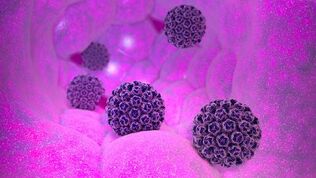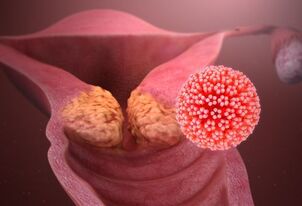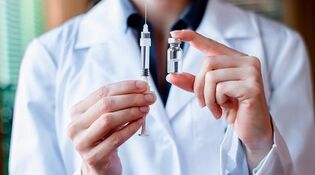
Human papillomavirus (HPV) is the common name for a group of DNA viruses that are transmitted from person to person and stimulate the growth of benign tumors - papillomas. Some varieties are carcinogenic (that is, they increase the risk of malignancies). The most common HPV is linked to cervical cancer, killing thousands of women worldwide each year. However, these viruses also affect the development of other cancers: not only in women, but also in men.
HPV does not manifest as symptoms for a long time: patients often only know about it when precancerous or cancerous conditions develop. HPV is a threat to patients of all sexes and ages, including young children. However, its main "target audience" is 15-30 year olds: they are sexually active, not always thinking about preventive measures, and in most cases, HPVsexually transmitted.
To prevent the impact of the virus on the body, you should regularly check your health: to rule out any pathologies it may cause. There are also tests for HPV to detect the presence of cancer-causing strains. Take care of your health right now: book an appointment at the Otradnoe General Clinic and visit your doctor without having to wait in line or adjust your inconvenience
What is HPV
Human papillomas, which enter the body through the skin's microscopes, are introduced into the cells of the basal layer of the epithelium. HPV can exist in any layer of the epidermis. However, its reproduction occurs only in the basic layer.
The growth of a virus occurs in two phases:
- Reproduction - virus enters cells without affecting its chromosomes and multiplies.
- Integrated - HPV is introduced into the genome of the infected cell.
In the second stage, the virus transforms the cell. They begin to actively divide and form like a tumor - a papilloma - that appears. These are papillae that protrude on the surface of the skin (which is why they are called: papillomas - from Latin papilla - nipples and oma - tumors in Greek). The second stage doesn't always happen. Viruses are in their first stage of development capable of regressing (leaving the body). However, even if the patient does not have a medical change, he or she is also a carrier of the HPV virus and is capable of transmitting to others.
Incubation period can last from 3 weeks to a year. Average is 3 months. In some cases, non-genital papillomas appear first, then papillomas appear on the genitals.

In most cases, the body cope with the virus within 2 years. However, reinfection can occur - with the same strain or with another strain. In addition, papillomas or other skin manifestations may regress after 6-8 months (gradually decrease and then disappear). This happens when the immune system stops the virus and "survives" from the cell.
The HPV virus usually affects the skin and mucous membranes:
- Genital anus area.
- Upper respiratory tract.
- Oral cavity.
- Bronchi.
- Linking words.
- Rectal.
- Esophagus.
Types of HPV
The first human papillomavirus (HPV) was isolated in 1971. And scientist Harald zur Hausen was able to identify and prove the link between HPV and cervical cancer. Later, he received the Nobel Prize for his discoveries.
About 600 different strains of HPV are known so far. Some irritate the appearance of warts, others - genital warts and others - papillomas. There are also types of HPV that affect the growth of cancerous tumors. These are called carcinogens. Luckily, there aren't many of them. They may have a low, medium, or high cancer potential:
- Strains 6, 11, 40, 42, 43, 44, 54, 61, 70, 72, 81 are characterized by low carcinogenicity.
- Average carcinogenicity of categories 26, 31, 33, 35, 51, 52, 53, 58, 66.
- High carcinogenicity in strains 16, 18, 39, 45, 56, 59, 68, 73, 82.
Cervical cancer is mainly caused by types 16 and 18.
Help!The presence of a cancer-causing HPV type in the body does not mean a person is "convicted" of cancer. Presence of viruses increases the risk of developing cancer, but is not the only reason for their occurrence.If the patient has a cancer-causing strain of HPV, it is only necessary to closely monitor the health, regularly examine the disease. If necessary, the doctor will prescribe the appropriate therapy for him.
The reproductive systems of women and men are capable of infecting about 40 types of papillomavirus. Their action not only leads to cancers, but also causes genital warts or seborrheic tumors.
Help!Cancerous tumors grow slowly: within 5-30 years after infection with papillomavirus. They predate precancerous conditions (benign tumors that can degenerate into malignancies). That is why it is important to have regular preventive testing. And precancerous conditions, even early cancer, are completely treatable and dangerous consequences are avoided.
The pathways of HPV
The main "condition" of an infection is the presence of small wounds (wounds, cracks, scratches) on the skin or mucous membranes. They are the “doorstep” for HPV.
Usually, virus transmission occurs when the skin or mucous membranes of two people come into contact. Therefore, the main path of infection of the papillomavirus is sex. Furthermore, using condoms does not preclude the possibility of infection. The virus can be transmitted through oral sex without always using birth control. In addition, the condom does not cover the entire surface of the penis, and it is often inserted between sexual intercourse. HPV can also be spread by kissing.
HPV can also be transmitted:
- From mother to baby when the baby passes through the birth canal.
- At home: when using other people's hygiene products (towels, toothbrushes, shaving accessories).
- In public places: sauna, gym, swimming pool.
Help!The lifetime of the papillomavirus in the external environment is short. Hence, the risk of infection in the water, though present, is much lower than for sex.
Can also be self-contagious: spread the virus from one part to another during hair loss, skin abrasions, nail biting.
Infection caused by exposure to viruses does not occur under all circumstances. The following factors increase the risk:
- Decreased immunity.
- Bad habits: smoking, abusing alcohol.
- Tension.
- Sexually transmitted diseases.
- Diseases of the urinary system.
- Damage to the skin and mucous membranes.
- Immunodeficiency state.
- Long-term use of hormonal contraception.
Help!Cancer-causing HPV strains are more dangerous for women than men, because they are infected with them more often.
HPV: symptoms
The Papillomavirus is likely to be completely asymptomatic for a long time. Usually, patients know about the presence of HPV along with the development of its consequences: the appearance of warts, papillomas, seborrheic tumors. In some cases, the following signs may indicate the presence of a virus:
- Redness, skin growth (most common in the genital area);
- Itching.
- Other pain and discomfort during or after sex.
What diseases can HPV cause?
First of all,Papillomavirus induces the development of papillomas, warts and genital warts in patients of both sexes. All of the above cancers can occur in any part of the body. However, most of them affect the genitals and the anal area. In women, they appear in the vulva, cervix, and vagina. In men - scrotum, tip of the penis, foreskin. In patients of both sexes often appear tumors in the anus.
In addition, warts often appear on the soles of the feet, larynx, and vocal cords. Papillomas (flesh-colored papillomas) don't have "places of interest" - they can appear on the body, neck, face, arms, and legs. In children and teenagers, flat warts are the most common (they are also known as small children or teenagers). These are small (3-5 mm) dark lumps that stick out on the skin's surface slightly. Usually they occur on the backs of hands, face, and feet.

For cancer, most patients have been associated with HPV, first of all cervical cancer. Indeed, this pathology is very common in our time. However, in women, HPV also often causes cancer of the vagina and vulva (65-70% of cases), in men - cancer of the penis (50% of cases). Also in women and men, papillomavirus can contribute to the appearance of malignant tumors:
- rectal;
- oral cavity;
- larynx.
In children, as a rule, HPV is manifested by the development of papillomas against the background of reduced immunity from previous diseases, usually viral or bacterial infection. In addition, the papillomavirus infects young patients with frequent cold or allergic reactions.
HPV and pregnancy
Papillomavirus negatively affects a woman's fertility. If they do appear, pregnancy is cut in half, as HPV can interfere with implantation of a fertilized egg. If a sexual partner is also infected with the virus (occurring in 65-70% of cases), the likelihood of conception is even greater. HPV has a negative effect on sperm motility.
During pregnancy, the papillomavirus increases the risk of developing:
- Few or more water molecules.
- Chronic placental failure.
- HPV can also cause a miscarriage.
Consequently, pregnant women are prescribed sparing drug therapy, which can significantly reduce all of the above risks.
When a child passes through the birth canal, there is a risk of infection. Therefore, women infected with HPV prefer giving birth by caesarean section - the risk of transmission is reduced by 5 times.
Changes in the hormonal background stimulate the rapid growth of genital warts. They can grow together, causing difficulty in urinating and defecating, causing discomfort while walking, or bleeding. During childbirth, the woman is very vulnerable. They can also make it difficult for the baby to pass through the birth canal. To avoid all of this, genital warts are treated early in pregnancy. Methods such as cold aspiration, laser surgery, etc. v. used.
Diagnosis

To diagnose HPV, they must first consult a doctor. Depending on the manifestations of the virus, the doctor will refer the patient to diagnostic studies and to a specialist specialist (gynecologist, urologist, dermatologist, oncologist, specialists, etc. ).
Both women and men can be assigned tests like:
- ELISA blood test - according to its results, it is impossible to determine the concentration and carcinogenicity of the virus, but can detect antibodies to it, the ideal method forEarly diagnosis, when symptoms have not appeared.
- PCR Diagnosis - allows you to determine the DNA of HPV, ie it lets you know exactly whether there is a virus in the body or not; Blood, saliva, genital secretions, etc. are collected for analysis.
- Digene-test - allows you to evaluate the carcinogen level of a strain, to determine the amount of virus in the body; Biological material is a piece of tissue, scraped from the cervical canal, vagina or urethra.
Women are prescribed the following forms of examination:
- Cytological examination (PAP test) - examines a stain from the vagina under a microscope to identify cells altered by a virus.
- Colposcopy - examination of the cervix with a colposcope, this procedure is indicated for patients if altered cells are found according to cytology test results.
Treatment
There is no specific treatment for HPV (that is, to destroy it). However, you can take steps to suppress the virus and increase your chances of getting better on its own. Patient is prescribed:
- Vitamins.
- Immune conditioning.
- Antiviral drug.
Symptomatic treatment is also performed - removal of the tumor. In any case, you should not try to treat seborrheic tumors, papillomas and warts with folk remedies. There is a risk of causing the development of secondary infection or the degeneration of a benign tumor into a malignant tumor.
The following methods are used to remove the tumor:
- Removes with a scalpel.
- Cryodestruction (frozen with liquid nitrogen).
- Removed with a radio knife.
- Laser removal.
- Coagulation of capacitors.
The method chosen by the doctor depends on the nature and location of the tumor, as well as the patient's physical condition.
Precautions

Preventive methods include maintaining a healthy lifestyle and regularly enhancing immunity with the help of a complete and varied diet, moderate physical activity andreasonable rest. It is important to follow the rules of personal hygiene, do not use other people's accessories. To avoid the risk of infection, you should limit normal sex and use birth control methods.
Additionally, there is a high chance of vaccination today against certain cancer-causing strains of HPV. Vaccination is recommended between the ages of 9 and 26 (optimal age is 11-12 years). Women can be vaccinated after age 26, but only if the gynecologist believes there is evidence. It should be noted that vaccination does not cure an already existing virus in the body, but prevents infection of some of its particularly dangerous types.

























